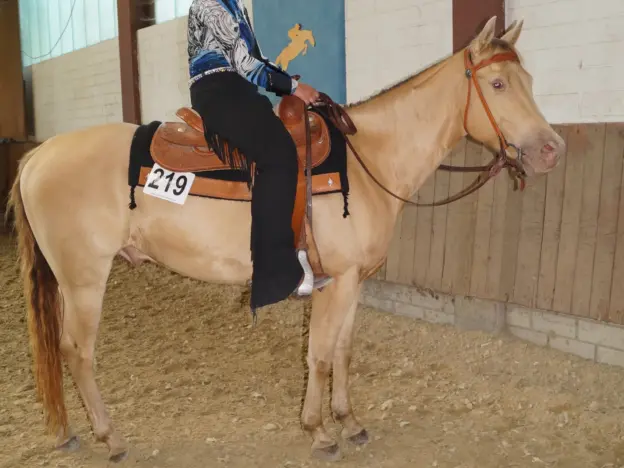Intro
The Champagne horse is a colored breed and is registered based upon their color rather than breed genetics. The champagne gene is common in several breeds and seems to be most apparent in gaited animals.
Origins
The rare champagne gene is still a bit of a mystery and its appearance has been traced back to the 19th century. The coloration appears to have originated in gaited saddle stock, which explains why is is so often found within gaited breeds.
Characteristics
The champagne gene creates a number of very distinct characteristics.
Skin
The skin of a newborn foal is bright pink and as they age it will begin to mottle. Generally exposed skin (around muzzle) will display this coloration.
Coat
This gene also gives a metallic sheen to the coat, which is believed to be due to a unique hair shaft structure. Foals are born the color of their base coat (bay, black, etc.) and reveal their champagne coat after they shed baby fur.
Eyes
The eye color of newborn foals is bright blue and as they age they go through various stages of green and usually to hazel. The adult eyes vary between green, gold and brown. When combined with other genes (namely pinto and creme) their eyes may remain bright blue.
Champagne Colors
The gene affects different colors differently, so the result is a rainbow of combinations.
Classic Champagne – From a black base, the body and points are all lightened to a chocolate or lilac color.
Gold Champagne – From a chestnut base, the body is lightened to gold and may have a flaxen mane & tail.
Amber Champagne – From a bay base, body is lightened to gold and points become chocolate.
Sable Champagne – From a brown base, body is lightened and points become chocolate.
Champagne Cream – The two dilutions enhance each other, chestnut becomes cream and black becomes rust.
Champagne Silver – The two dilutions enhance each other only on a black base and black pigment is further lightened.
Champagne Dun – The dun gene is dominant enough to suppress most of the champagne traits and they generally display primitive markings.
Champagne Roan – Perhaps most difficult to identify, the roan pattern may only cause the coat to appear lighter.
Physique
Because so many different breeds carry the gene, conformation standards follow that of their primary breed.
Traditional Colors
All colors affected by the champagne dilution gene
Temperament
Varies based on primary breed.
Use
Animals with this coloration are used within all aspects of the equine industry.
Helpful Links
* all links open in a new window
International Champagne Horse Registry
Champagne Horse Breeders’ & Owners’ Association
Champagne Horse Genetics
